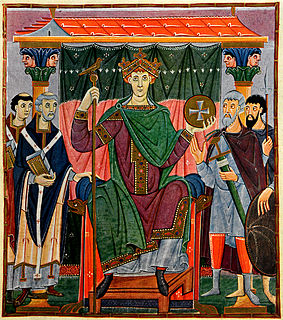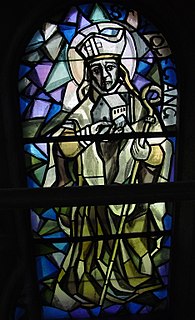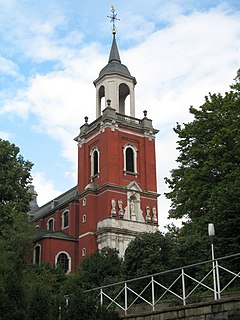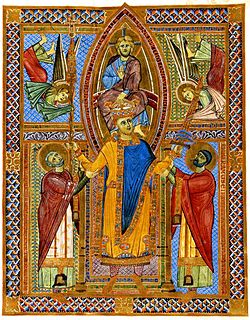
Adelaide of Italy, also called Adelaide of Burgundy, was Holy Roman Empress by marriage to Emperor Otto the Great; she was crowned with him by Pope John XII in Rome on 2 February 962. She was the first empress designated consors regni, denoting a "co-bearer of royalty" who shared power with her husband. She was essential as a model for future consorts regarding both status and political influence. She was regent of the Holy Roman Empire as the guardian of her grandson in 991–995.
The 990s decade ran from January 1, 990, to December 31, 999.
Year 999 (CMXCIX) was a common year starting on Sunday of the Julian calendar, the 999th year of the Common Era (CE) and Anno Domini (AD) designations, the 99th year of the 1st millennium, the 99th year of the 10th century, and the 10th and last year of the 990s decade.

Otto III was Holy Roman Emperor from 996 until his early death in 1002. A member of the Ottonian dynasty, Otto III was the only son of the Emperor Otto II and his wife Theophanu.

Heiligenkreuz Abbey is a Cistercian monastery in the village of Heiligenkreuz in the southern part of the Vienna woods, c. 13 km north-west of Baden in Lower Austria. It is the oldest continuously occupied Cistercian monastery in the world.

Saint Wolfgang of Regensburg was bishop of Regensburg in Bavaria from Christmas 972 until his death. He is a saint of the Catholic and Eastern Orthodox churches. He is regarded as one of the three great German saints of the 10th century, the other two being Saint Ulrich of Augsburg and Saint Conrad of Constance. Towards the end of his life Wolfgang withdrew as a hermit to a solitary spot, in the Salzkammergut region of Upper Austria. Soon after Wolfgang's death many churches chose him as their patron saint, and various towns were named after him.

Gotthard, also known as Gothard or Godehard the Bishop, was a German bishop venerated as a saint.

Nilus the Younger, also called Neilos of Rossano was a monk, abbot, and founder of Italo-Byzantine monasticism in southern Italy. He is venerated as a saint in the Eastern Orthodox and Roman Catholic churches, and his feast day is celebrated on September 26 in both the Byzantine Calendar and the Roman Martyrology.

Burtscheid Abbey was a Benedictine monastery, after 1220 a Cistercian nunnery, located at Burtscheid, near Aachen, North Rhine-Westphalia, in Germany.

Saint Emmeram's Abbey, now known as Schloss Thurn und Taxis, Schloss St. Emmeram or St. Emmeram's Basilica, was a Benedictine monastery founded in about 739 at Regensburg in Bavaria at the grave of the itinerant Frankish bishop Saint Emmeram.

Tegernsee Abbey is a former Benedictine monastery in the town and district of Tegernsee in Bavaria. Both the abbey and the town that grew up around it, are named after the Tegernsee, the lake on the shores of which they are located. The name is from the Old High German tegarin seo, meaning great lake.

Saint Blaise Abbey was a Benedictine monastery in the village of St. Blasien in the Black Forest in Baden-Württemberg, Germany.

Burtscheid is a town in western Germany, near Aachen. It was inhabited since ancient times by Celts and Romans, who were attracted by the presence of hot springs.

The 1159 papal election following the death of Pope Adrian IV resulted in a double papal election. A majority of the cardinals elected Cardinal Rolando of Siena as Pope Alexander III, but a minority refused to recognize him and elected their own candidate Ottaviano de Monticelli, who took the name Victor IV, creating a schism that lasted until 1178.

Michaelsberg Abbey or Michelsberg Abbey, also St. Michael's Abbey, Bamberg is a former Benedictine monastery in Bamberg in Bavaria, Germany. After its dissolution in 1803 the buildings were used for the almshouse Vereinigtes Katharinen- und Elisabethen-Spital, which is still there as a retirement home. The former abbey church remains in use as the Michaelskirche.

The Abbey of Fulda, from 1221 the Princely Abbey of Fulda and from 1752 the Prince-Bishopric of Fulda, was a Benedictine abbey and ecclesiastical principality centered on Fulda, in the present-day German state of Hesse.

Henry II, also known as Saint Henry the Exuberant, Obl. S. B., was Holy Roman Emperor from 1014. He died without an heir in 1024, and was the last ruler of the Ottonian line. As Duke of Bavaria, appointed in 995, Henry became King of the Romans following the sudden death of his second cousin, Emperor Otto III in 1002, was made King of Italy in 1004, and crowned emperor by Pope Benedict VIII in 1014.

November 3 - Eastern Orthodox liturgical calendar - November 5

The Abbey of Santa Giustina is a 10th-century Benedictine abbey complex located in front of the Prato della Valle in central Padua, region of Veneto, Italy. Adjacent to the former monastery is the basilica church of Santa Giustina, initially built in the 6th century, but whose present form derives from a 17th-century reconstruction.

Arnoldstein Abbey was a Benedictine abbey in Arnoldstein in Carinthia, Austria. Its church was dedicated to St George and first mentioned in historical records in 1316 - its choir, tower, west door and a few buttresses can still be seen. The monastery buildings from the Gothic and 17th century eras were arranged around the church in an oval.


















